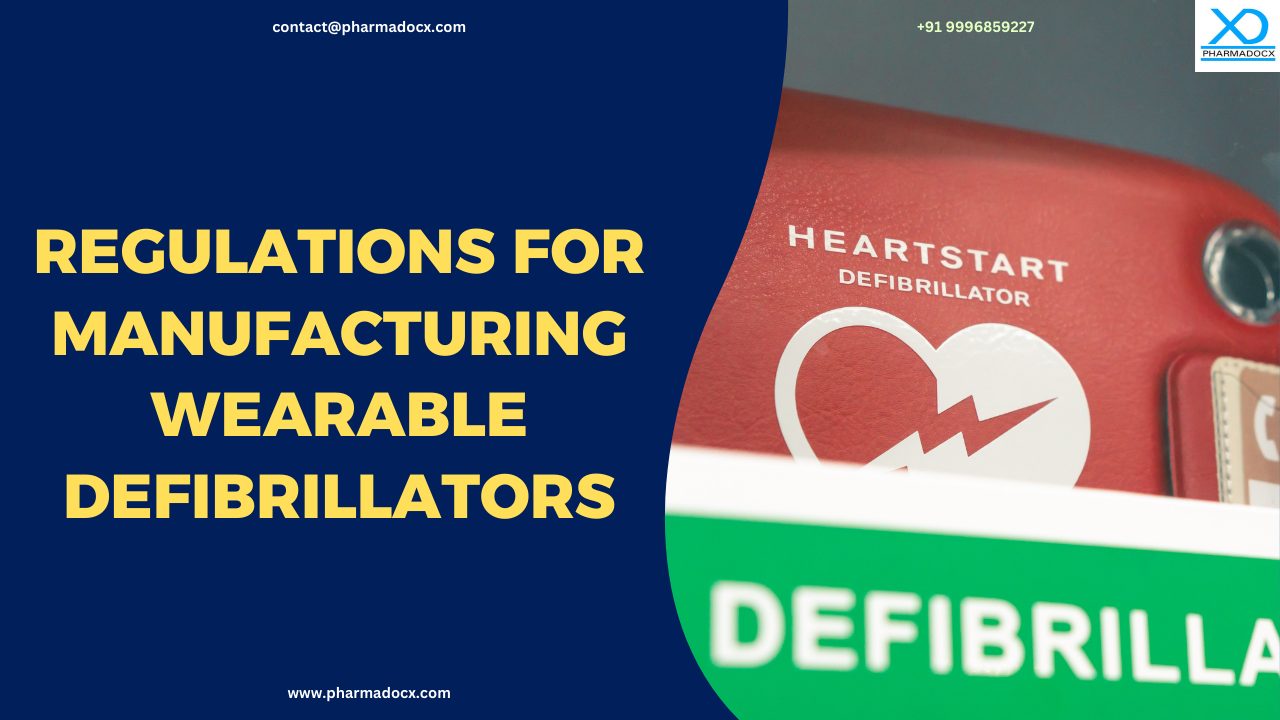Wearable defibrillators are non-invasive lifesaving medical devices. Hence, their manufacturing process is strictly regulated. In this blog, we have discussed the wearable defibrillator manufacturing process. Additionally, we have highlighted the regulations for manufacturing wearable defibrillators in India.
What is a wearable defibrillator?
A wearable defibrillator is a non-invasive external medical device worn by patients at risk of sudden cardiac arrest. It continuously monitors the patient’s heart rhythm. It automatically delivers a life-saving electrical shock to restore the normal heart rhythm in case a dangerous arrhythmia is detected. Unlike implantable cardioverter defibrillators (ICDs), wearable defibrillators do not require surgical implantation. Hence, they are ideal for temporary use. Thus, these devices are suitable for patients who are not suited for ICDs or are awaiting surgery. Given their importance in healthcare delivery, stringent regulations for manufacturing wearable defibrillators are in place.
Who uses a wearable defibrillator?
- Patients who have suffered recent heart attack
- Newly diagnosed cardiomyopathy
- Post-revascularization
- Post ICD removal
Key components of a wearable defibrillator
For manufacturing wearable defibrillators, an understanding of their critical components is required:
- Wearable vest for proper contact with the skin.
- Sensors that monitor cardiac rhythms and detect arrhythmias.
- Microprocessor and software that analyzes data. Additionally, it triggers shock when needed.
- Defibrillation circuit that deliver electrical shock to restore heart rhythm.
- Remote monitoring system for healthcare providers.
- Battery pack for portability.
While manufacturing wearable defibrillators, each component should be manufactured with regulatory guidelines in mind.
How do wearable defibrillators work?
- The wearable vest worn underneath the clothing contains monitoring and defibrillation electrodes.
- An inner belt with ECG electrodes remains in direct contact with the skin to monitor the heart’s electrical activity.
- A small, battery-powered monitor worn on the belt or shoulder strap analyzes the heart rhythm data from the electrodes.
- Defibrillation circuit delivers electrical shock to restore the heart rhythm
How is the treatment delivered?
The wearable defibrillator delivers treatment in less than a minute. It does not require intervention from another person or a healthcare professional:
- The defibrillator’s monitor constantly analyzes the heart rhythm. If a life-threatening arrhythmia is detected, an alarm cascade begins.
- The device uses audible alarms, vibrations, and visual signals to warn the patient of an impending shock.
- The patients are given a short time (usually less than a minute) to press response buttons to cancel the shock. If the patient does not respond, it is assumed they have lost consciousness.
- If no response is made, the wearable defibrillator automatically releases a conductive gel from the electrodes to facilitate a defibrillation shock. It can deliver up to five consecutive shocks to restore a normal heart rhythm.
- Abnormal heart rhythm data and treatment records are automatically transmitted to a secure server for the healthcare professional to review.
Manufacturing wearable defibrillators: A 6-step guide
Manufacturing wearable defibrillators is a multi-step process. Advanced electronics and software have to be integrated into a custom-fitted wearable textile vest. The wearable defibrillator manufacturing process has to be per regulatory guidelines to consistently produce safe, reliable, and effective defibrillators.
- Designing and developing the defibrillator: Conduct a user needs analysis based on clinical input. Ensure compliance with industry guidelines for electrical safety. Develop the defibrillator embedded software per IEC 62304 standards.
- Component sourcing: Biocompatible and EMC-compliant components have to be procured. Raw material quality will determine the final product quality. Hence, it is vital to cautiously choose the raw material and component supplier for manufacturing wearable defibrillators. Select suppliers with ISO 13485-certified systems.
- Manufacturing the wearable vest: Durable, comfortable, and often washable fabric is used to manufacture the wearable vest. Skilled technicians sew the fabric pieces together, including compartments for electrodes and cabling.
- Manufacturing the electronics and electrodes: Electrodes for detecting the heart’s rhythm are integrated into the wearable vest. Additionally, large self-gelling electrodes are embedded in the vest for delivering a shock. A power sources is also integrated into the component.
- Manufacturing the monitor and user interface: A portable, battery-powered device that houses the processing and power components have to be integrated into the wearable vest. The user interface with visual and audible alarms, a vibration motor, and patient response buttons are all parts of this component.
- Assembling the defibrillator: It is important to properly assemble the defibrillator per regulations for proper and safe functioning of the device. Good manufacturing practices (GMP) guidelines should be followed at all stages. Cleanroom should be used to assemble all critical components.
- Testing and validation of the device: Thoroughly conduct functional, electrical safety, and EMC testing of the wearable defibrillator. Perform software verification and validation as well as risk assessments. Perform clinical evaluation or simulated use testing of the device.
- Packaging and sterilization: Properly sterilise the device per applicable industry guidelines. Use protective packaging to maintain device integrity. Ensure compliance with medical device regulatory guidelines for labeling the device.
- Post-market surveillance: Post-market surveillance of medical devices is a mandatory requirement of most regulatory guidelines. Post-market surveillance is necessary to monitor the real-world functioning of the device. Plan for ongoing safety monitoring and reporting once the device is in the market should be in place. Additionally, have an adverse event reporting plan in place. Furthermore, implement complaint-handling procedures to deal with customer feedback and complains.
For manufacturing wearable defibrillators, strict quality control and regulatory approval are necessary. This is because wearable defibrillators are life-saving medical devices.
Benefits of a wearable defibrillator
We have highlighted some of the advantages of using a wearable defibrillator.
- Non-invasive: Wearable defibrillators are non-invasive medical devices. They do not require surgery. Hence, risks associated with an ICD implant, such as bleeding, infection, and long-term hardware complications, can be avoided by using this device.
- Continuous protection: It provides constant monitoring and protection from fatal arrhythmias. The wearable defibrillator is effective even when the patient is alone or sleeping.
- High efficacy: The wearable defibrillator has a high success rate. In most cases, it can convert life-threatening ventricular arrhythmias back to a normal heart rhythm.
- Conscious override: A conscious patient can avert a shock by responding to the device’s alarm systems. The patient can avoid unnecessary and painful shocks for non-life-threatening triggers.
Regulations for manufacturing wearable defibrillators in India
Central Drugs Standard Control Organization (CDSCO) is the apex medical device regulatory body in India. Hence, in India wearable defibrillators are regulated by CDSCO. Wearable defibrillator manufacturers must comply with the Medical Devices Rules, 2017, to legally market their products in India.
- CDSCO medical device class: The CDSCO has classified medical devices into various classes for ease of licensing and registration purpose. The CDSCO medical device class will determine the applicable medical device regulatory pathway. To secure your CDSCO medical device license, you need to understand which CDSCO class your medical device belongs to. Based on their associated risk level and intended use, wearable defibrillators belong to Class C or Class D.
- CDSCO medical device license: For manufacturing wearable defibrillators in India, CDSCO MD-9 license will be required. Compliance with all provisions under the Medical Devices Rules, 2017, is mandatory to secure the license.
- Quality management system: A quality management system per ISO 13485 guidelines will have to be set up. This system ensures consistent product quality and traceability. Additionally, an ISO 13485:2016 compliant QMS is mandatory for securing CDSCO approval and license.
- Defibrillator labeling guidelines: All wearable defibrillators must carry CDSCO-compliant labels. It should contain manufacturing license number, batch number, expiration date, and storage conditions. Additionally, unique device identification (UDI) may be included.
Hence, for manufacturing wearable defibrillators in India, knowledge of CDSCO medical device regulations is required. We at Pharmadocx Consultants have extensive knowledge of the CDSCO medical regulatory guidelines. We will help you easily launch regulatory compliant wearable defibrillators in India. Email at [email protected] or call/Whatsapp on 9996859227 to let us help you have a smooth regulatory journey.





